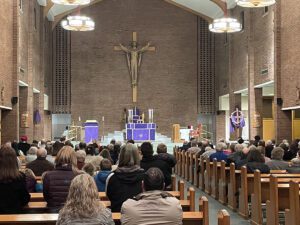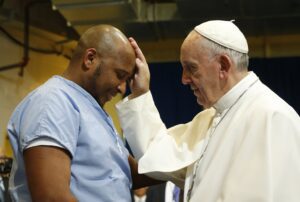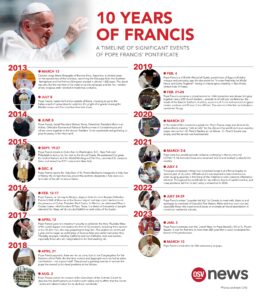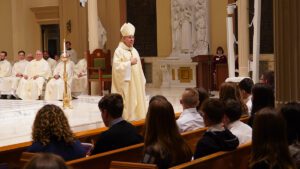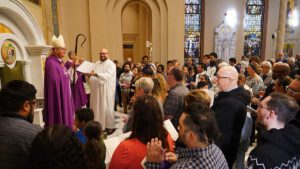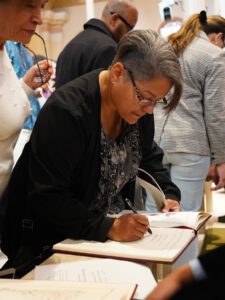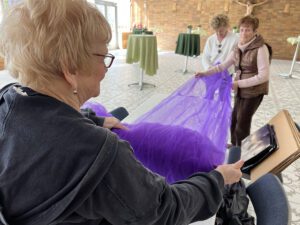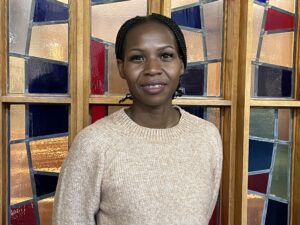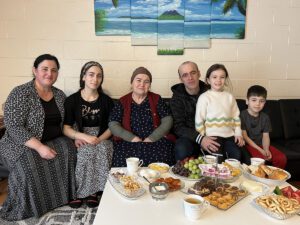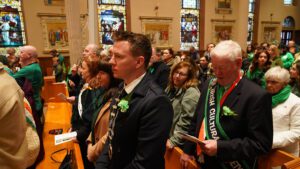SOUTH ABINGTON TWP. – On behalf of the faithful of the Diocese of Scranton, the Most Rev. Joseph C. Bambera, Bishop of Scranton, welcomed a community of ten Carmelite nuns to northeastern Pennsylvania on Sunday, Feb. 26, 2023, the First Sunday of Lent.
“I speak on behalf of the people of the Diocese of Scranton in saying ‘welcome Sisters,’” Bishop Bambera said while celebrating Mass with them. “We are so, so honored and blessed to have you be a part of this local church, a part of this Christian community of believers.”
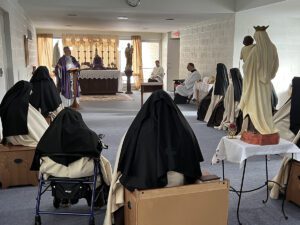
Earlier in the month, the cloistered Carmelite nuns from the Monastery of Our Lady of Mount Carmel and Saint Joseph relocated from Brooklyn, N.Y., to a temporary home at the former Saint Gabriel’s Retreat Center near Clarks Summit.
Their current location is expected to be only temporary because the Carmelite nuns have plans to build a new monastery on land in Pleasant Mount in Wayne County.
“This place has had a tradition of being a real refuge for many people. I know it may not be part of your tradition but many people have had retreats here. It has been a place of prayer, a place of discernment and just a wonderful place where God’s people have come together,” Bishop Bambera explained to the nuns prior to blessing their current home.
The Discalced Carmelite nuns, who pray for the Church and for the world, especially for the sanctification of priests and the salvation of souls, decided to relocate from Brooklyn because of late night partying by teenagers and young adults in a park next to their former home that was disruptive to their prayer work.
On their website, the nuns wrote the park has “proved to be a real problem and in recent times, even a danger for our Community … Worse than the noise, however, is the late night carousing, drinking and drugs, as well as the evidence of satanic rituals just feet away from us. Under such conditions it is impossible for our Community to grow and flourish.”
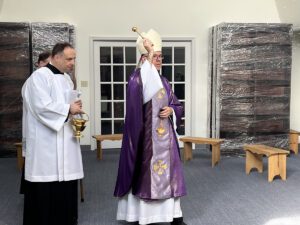
In beginning his homily for the Carmelite nuns, Bishop Bambera noted they had been an important part of the Brooklyn diocese for nearly 20 years.
“I know first-hand from Bishop DiMarzio, Bishop Brennan, Bishop Chappetto, Bishop Sanchez and Bishop Octavio, they are sorry to see you leave,” he said. “Their loss, as they’ve said to me, is our blessing and we are so grateful.”
Bishop Bambera also reflected on the Gospel passage for the First Sunday in Lent, which was about the temptation of Jesus in the desert.
“He goes into the desert, into the wilderness, probably something like this part of northeastern Pennsylvania or Pleasant Mount, and He prepares for His public ministry,” the bishop said. “At that moment, in the quiet solitude of the desert, He begins to reflect and discern all the more intently, more so than He had done throughout his 30 years of life to that point, what the Father was calling Him to do and to be.”
Not unlike what the Sisters have embarked on, the desert was a time of “great transition, reflection and change.”
Bishop Bambera told the nuns the real blessing in the Gospel account is that every day each of us is confronted with choices and given the opportunity to hand ourselves over to God and thus be used by God.
“I face choices every day of my ministry as Bishop and I dare say Sisters, you face those choices as well. As the spirit has led you into the wilderness of northeastern Pennsylvania, you face a lot of choices … We simply need to trust in the power of God.”
As he reflected on the former Saint Gabriel Monastery property a little more, Bishop Bambera encouraged the Sisters to trust where God’s goodness and mercy leads them.
“This was a monastery for Passionist Sisters. Providentially, I don’t know if this is in your plans yet, but they had a place where they baked altar breads. I know that is something that you will, or plan, to do as you did in Brooklyn,” Bishop Bambera said.
“May we have the humility and the wisdom to pray that the Lord will touch our hearts so that we may trust in God’s way, in God’s will and in God’s plan, and together in the ways given to us by God help to build his kingdom.”
The Carmelite nuns of the Monastery of Our Lady of Mount Carmel and Saint Joseph are currently raising donations for their new home in the Pleasant Mount area. Plans for new Community call for it to be an authentic Spanish Carmel, like those in which Saint Teresa of Jesus and her daughters lived.
The monastic enclosure is being designed for 24 nuns, a chapel that seats 148 and facilities for baking altar bread and communion wafers that would be sent out for use by parishes across the country.
“The monastery is designed in a Spanish Carmelite style, taking its inspiration from the monastic home of Saint Teresa in Avila, Spain, Joel Pidel, lead designer, said.
“The monastery will even share Avila’s distinctive feature of being situated on a hilltop, visible for miles around.”
Erik Bootsma is the architect leading the planning and execution of the planned project in Pleasant Mount.
“It is a privilege to help to facilitate the growth of such a vibrant, devout religious order,” Bootsma said. “The new Monastery will truly be a beautiful center of prayer, built in stone in the classical style.”
As he ended his time with the Carmelite nuns, Bishop Bambera simply told the Sisters they are more welcome in northeastern Pennsylvania than they know.
“We are very touched by your presence and most especially very grateful for your prayers. I know that is the heart of your ministry and we know that we have a special place in that heart,” Bishop Bambera said. “Thank you for all that you have done for us and all that you will continue to do. I hope you feel at home here.”
To learn more about the plans for the Discalced Carmelite nuns, or to donate to their planned Monastery in Pleasant Mount, visit pleasantmountcarmel.org.

